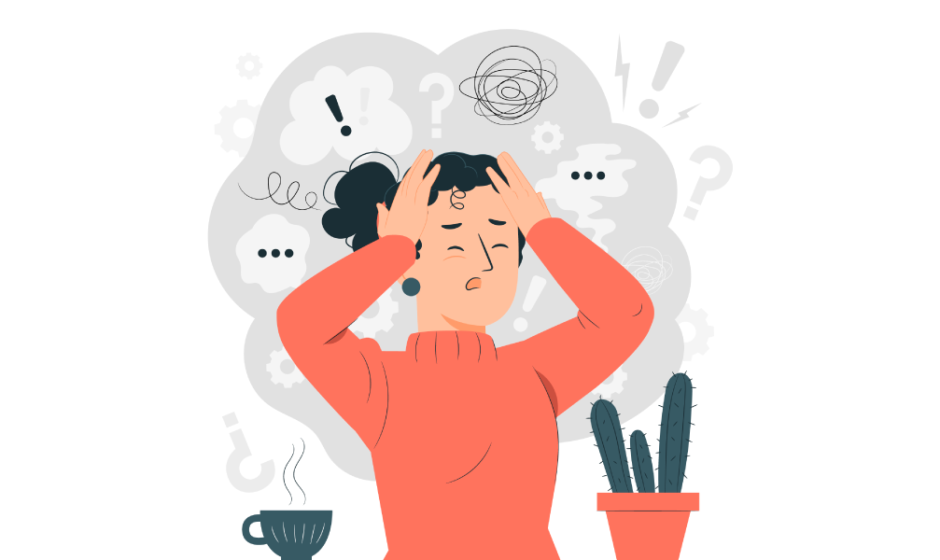Anxiety is often described as a “silent storm”—an invisible force that churns in the depths of the mind, creating turmoil and distress without showing clear outward signs. While many may associate anxiety with noticeable symptoms like nervousness, restlessness, or rapid heartbeat, its most profound effects are frequently hidden from the view of others. It is an internal struggle that, for many, becomes an unspoken burden, making it difficult to express the depth of the experience to others. This article explores the complexities of living with anxiety, shedding light on its invisible nature, its impact on daily life, and the challenges of navigating a world that does not always recognize or understand mental health struggles.
Understanding Anxiety: More Than Just Worry
Anxiety is often misunderstood as simple worry, but it is much more than that. Anxiety disorders encompass a range of conditions, including generalized anxiety disorder (GAD), social anxiety disorder, panic disorder, and specific phobias. At its core, anxiety is a heightened state of fear or unease, often without a clear or rational cause. The body’s response to anxiety mirrors the fight-or-flight reaction—elevated heart rate, increased blood pressure, shallow breathing, and muscle tension—but in a modern world, these physiological responses are triggered by psychological stressors rather than physical danger.
While worry is a natural part of life, for those with anxiety disorders, it is a constant and pervasive presence. Thoughts spiral into overthinking, often centered around worst-case scenarios, future uncertainties, or fears of judgment. It is a state where the mind races, but the body feels paralyzed, caught in a perpetual loop of what-ifs. Even in situations where no immediate threat exists, the body may still respond with extreme anxiety, rendering the individual unable to relax or feel at ease.
The Invisible Nature of Anxiety
One of the most challenging aspects of living with anxiety is that it often goes unnoticed by others. Unlike physical illnesses or injuries, anxiety doesn’t present with visible symptoms. Someone experiencing a panic attack may appear calm to an outside observer, yet internally, they might feel as though they are drowning, unable to catch their breath, and overwhelmed by a sense of impending doom. This disparity between what others see and what the individual feels can make it incredibly isolating.
The lack of physical signs of anxiety can lead to misunderstandings. Friends, family, and colleagues may struggle to empathize, as the person grappling with anxiety might appear to be “overreacting” or “just worrying too much.” These misconceptions can lead to invalidating experiences, where the individual is dismissed or told to “calm down,” when in reality, they have no control over the emotional turmoil they are experiencing. The isolation that stems from these misunderstandings can exacerbate feelings of loneliness and self-doubt, making it even harder to seek help or share the experience with others.
The Impact of Anxiety on Daily Life
For someone living with anxiety, even the simplest tasks can become monumental challenges. Going to work, attending social gatherings, or running errands may feel like insurmountable hurdles. The constant mental effort to suppress anxious thoughts can be draining, leaving the individual physically and emotionally exhausted.
Workplace Anxiety
Anxiety in the workplace can have significant implications for productivity and career growth. The constant worry about making mistakes, being judged, or not measuring up can create a cycle of self-sabotage. In some cases, the fear of being exposed as “incompetent” or “not good enough” leads to avoidance of new challenges, missed opportunities, or burnout from overcompensating. Individuals with anxiety may also experience difficulty in meetings or presentations, where the fear of speaking up or being scrutinized takes a significant toll on their self-esteem and confidence.
Social Anxiety and Isolation
Social situations can be particularly challenging for those with anxiety, especially social anxiety disorder. The fear of being judged, embarrassed, or misunderstood can prevent individuals from engaging in normal social interactions, leading to social withdrawal and isolation. Even the thought of attending a social gathering, making small talk, or initiating conversation can feel overwhelming. Over time, this avoidance can lead to a sense of disconnection from others, further deepening feelings of loneliness and alienation.
Physical Symptoms
Although anxiety is primarily a mental health condition, it manifests in various physical symptoms as well. Chronic anxiety can contribute to headaches, digestive issues, muscle tension, sleep disturbances, and fatigue. The body is constantly on alert, which can take a serious toll on overall health. For some individuals, anxiety can exacerbate pre-existing conditions, such as asthma or irritable bowel syndrome (IBS), creating a vicious cycle where anxiety causes physical symptoms, which in turn heightens anxiety.
The Mental Toll: Cognitive and Emotional Struggles
Beyond the physical and behavioral effects, anxiety has a profound impact on an individual’s cognitive and emotional well-being. One of the most common cognitive distortions associated with anxiety is catastrophizing—where the individual tends to view a situation as far worse than it actually is. This thought pattern can lead to unnecessary stress and prevent effective problem-solving. For example, someone with anxiety might dread an upcoming event, imagining every possible negative outcome, even though the event may go perfectly well in reality.
Another cognitive struggle is the sense of constant vigilance. Individuals with anxiety often feel like they are in a perpetual state of readiness for danger, even when no immediate threat is present. This heightened alertness can lead to difficulties concentrating, as the mind is frequently preoccupied with worries and “what-ifs.” The constant noise in the mind can prevent individuals from fully engaging with the present moment, making it difficult to enjoy life or focus on important tasks.
Emotionally, anxiety can lead to feelings of inadequacy, guilt, and shame. Those who struggle with anxiety often feel that they are “weak” or “not normal” for experiencing such intense emotional responses. They may also fear that they are burdening others with their struggles, further contributing to a sense of isolation. This self-criticism can perpetuate the cycle of anxiety, making it harder to break free from negative thought patterns and seek help.
The Path to Healing: Seeking Help and Managing Anxiety
Living with anxiety can feel overwhelming, but it is important to recognize that help is available. Managing anxiety often requires a combination of self-care strategies, professional support, and lifestyle adjustments. Here are some approaches that can help individuals cope with the effects of anxiety:
Therapy and Counseling
Cognitive-behavioral therapy (CBT) is one of the most effective treatments for anxiety disorders. CBT helps individuals identify and challenge negative thought patterns and replace them with healthier, more balanced ways of thinking. Therapy can also help individuals develop coping mechanisms for managing anxiety in real-world situations.
Medication
In some cases, medication may be prescribed to help manage the symptoms of anxiety. Antidepressants and anti-anxiety medications can help regulate the brain chemicals that contribute to anxiety. Medication is typically most effective when combined with therapy and other supportive practices.
Mindfulness and Relaxation Techniques
Mindfulness meditation, deep breathing exercises, and progressive muscle relaxation are powerful tools for calming the nervous system. These practices help individuals stay present and focused, reducing the intensity of anxious thoughts. Over time, mindfulness can build emotional resilience, enabling individuals to respond to anxiety in a healthier way.
Support Networks
Having a strong support system is essential for managing anxiety. Talking to trusted friends, family members, or support groups can provide comfort and validation. It is also important to seek out people who understand anxiety, as they can offer practical advice and encouragement.
Lifestyle Adjustments
Exercise, healthy eating, and adequate sleep are foundational to mental well-being. Regular physical activity, for example, helps release endorphins, which can improve mood and reduce anxiety. Prioritizing self-care and managing stress through time management and relaxation techniques can also prevent anxiety from becoming overwhelming.
Conclusion:
Anxiety may be a silent storm, but it is far from invisible. While the struggle is often internal and unseen, the effects can be profoundly impactful on an individual’s life. It is crucial that we recognize the invisible nature of anxiety and approach those who live with it with empathy, understanding, and support. Through therapy, medication, mindfulness, and a strong support network, individuals with anxiety can learn to manage their symptoms and reclaim their sense of control. By breaking the silence around mental health and opening up conversations about the invisible struggles of living with anxiety, we can create a more compassionate and inclusive world for those who experience this silent storm.



